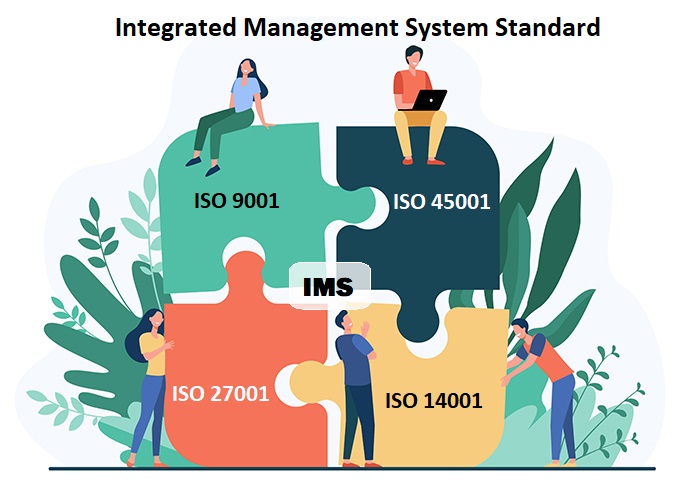Latest from the Blog
Get Updates about ISO Documentation, Training and Certification done by Global Manager Group
August 22, 2023
What is the Purpose of an IMS and How to Implement it in the Organization?

An integrated management system is a management system that unifies all or a portion of an organization's systems and procedures into a single comprehensive framework, allowing the organisation to operate as a single entity with shared goals. No matter the size or industry, Integrated Management applies to any organisation that wants to combine two or more of its management systems into a single, cohesive system with a comprehensive collection of documents, policies, procedures, and processes. The organisations that are often most responsive to this solution will be those with maturing management systems that want to introduce other management systems to their organisation and reap the benefits those systems have to offer.
Integrated management systems work to increase productivity, safety protocols, quality assurance, and risk management. An IMS standard also integrates, contrasts, and compares several standards. It defines the common and distinctive features of a management system. Plans, objectives, processes, or resources are a few examples of these. It establishes a unified policy for management reviews, internal audits, IMS auditor training, document control, and process improvements. You can find these commonalities by putting numerous standards into practice at once, which can help your business save a lot of money. By combining many management systems and establishing uniform goals, processes, and resources, IMS enhances accountability.
A company's procedures are better coordinated when it uses an IMS. The system becomes simpler and easier to learn when it is consistent. The team will be better able to focus on achieving the same goals by upholding homogeneity. Additionally, it eliminates pointless procedures to cut down on red tape. Red tape-related issues arise when firms implement several management standards in isolation. The management systems of the company might be integrated to provide a more methodical approach. The ability of the processes to adjust to changes is stronger. Additionally, the IMS standard performs comprehensive audits and evaluations and optimises processes and resources. It is possible to reduce wastage of time, interruptions, and overall costs by combining these tasks.
A streamlined and effective process for fulfilling such standard requirements is made possible by an IMS. It distributes funds to worthwhile projects. After establishing an integrated management system, IMS enables uniform audits. Integrated audits can increase the amount of database storage available, store the audit trail in the database with clarity, and enhance auditing efficiency. The steps that must be taken when implementing the IMS in the organisation are listed below:
- Training and Information Sharing: Notify and train all staff in the organisation about the IMS standards. Employees in leadership, middle, and entry-level positions should all attend training sessions. Being informed motivates staff to work together to achieve the common objective of implementing an ISO-compliant management system.
- Creating Policies and Objectives: Ensure that all quality, environmental, and health policies and related goals reflect the company's vision, mission, goals, and strategic direction. collaborate on the creation of the policy with senior leadership.
- Gap Analysis: Determine the level of compliance by evaluating how well your current system matches the criteria of the standards you're considering for your IMS. To identify differences, compare current practices against the ISO standard's prerequisites.
- Process Design: Outline processes by the applicable standards' criteria. Create a user guide, work instructions, functional procedures, system procedures, and associated forms that cover the operations of the organisation.
- Process Implementation: Put the designed processes and documents in place. Organise a workshop to talk about putting the required policies and IMS documents into place to satisfy the requirements of the applicable ISO standards.
- Internal Audit: A strong internal auditing system is essential for every business. However, if internal auditors have acquired the appropriate training, audits are more likely to produce worthwhile results. A complete internal audit of the entire organisation is performed by qualified auditors. To fill in any gaps found and to ensure the effectiveness and compliance of the IMS, make the necessary changes in each audited department.
- Senior Management Review: Allow senior management to evaluate how the organisation does about the standards. Review the results of the following:
- IMS Policies and objectives
- Internal audit results
- Process performance results
- Complaint/feedback/legal compliance results
- Risk assessment results
- Pre-Certification Gap Analysis: Analyse the effectiveness and compliance of your IMS. To illustrate how much the IMS fulfils the requirements, an audit that closely resembles the final certification audit would be helpful. It can also demonstrate how to finish the certification audit.
- Corrective Actions: Resolve any nonconformities that the gap analysis found. The organisation is now fully prepared for the certification audit after completing this phase.
- Certification Audit: Fix any nonconformities that the gap analysis uncovered. Following the completion of this phase, the organisation is now entirely ready for the certification audit.



Comment (0)